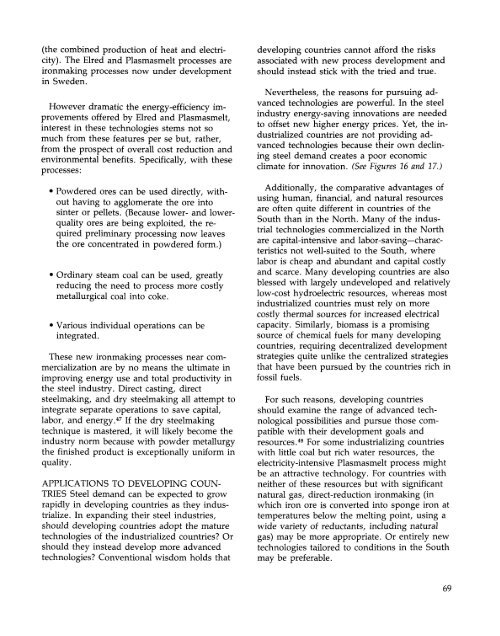ENERGY FOR A SUSTAINABLE WORLD - World Resources Institute
ENERGY FOR A SUSTAINABLE WORLD - World Resources Institute
ENERGY FOR A SUSTAINABLE WORLD - World Resources Institute
Create successful ePaper yourself
Turn your PDF publications into a flip-book with our unique Google optimized e-Paper software.
(the combined production of heat and electricity).<br />
The Elred and Plasmasmelt processes are<br />
ironmaking processes now under development<br />
in Sweden.<br />
However dramatic the energy-efficiency improvements<br />
offered by Elred and Plasmasmelt,<br />
interest in these technologies stems not so<br />
much from these features per se but, rather,<br />
from the prospect of overall cost reduction and<br />
environmental benefits. Specifically, with these<br />
processes:<br />
• Powdered ores can be used directly, without<br />
having to agglomerate the ore into<br />
sinter or pellets. (Because lower- and lowerquality<br />
ores are being exploited, the required<br />
preliminary processing now leaves<br />
the ore concentrated in powdered form.)<br />
• Ordinary steam coal can be used, greatly<br />
reducing the need to process more costly<br />
metallurgical coal into coke.<br />
• Various individual operations can be<br />
integrated.<br />
These new ironmaking processes near commercialization<br />
are by no means the ultimate in<br />
improving energy use and total productivity in<br />
the steel industry. Direct casting, direct<br />
steelmaking, and dry steelmaking all attempt to<br />
integrate separate operations to save capital,<br />
labor, and energy. 47 If the dry steelmaking<br />
technique is mastered, it will likely become the<br />
industry norm because with powder metallurgy<br />
the finished product is exceptionally uniform in<br />
quality.<br />
APPLICATIONS TO DEVELOPING COUN-<br />
TRIES Steel demand can be expected to grow<br />
rapidly in developing countries as they industrialize.<br />
In expanding their steel industries,<br />
should developing countries adopt the mature<br />
technologies of the industrialized countries? Or<br />
should they instead develop more advanced<br />
technologies? Conventional wisdom holds that<br />
developing countries cannot afford the risks<br />
associated with new process development and<br />
should instead stick with the tried and true.<br />
Nevertheless, the reasons for pursuing advanced<br />
technologies are powerful. In the steel<br />
industry energy-saving innovations are needed<br />
to offset new higher energy prices. Yet, the industrialized<br />
countries are not providing advanced<br />
technologies because their own declining<br />
steel demand creates a poor economic<br />
climate for innovation. (See Figures 16 and 17.)<br />
Additionally, the comparative advantages of<br />
using human, financial, and natural resources<br />
are often quite different in countries of the<br />
South than in the North. Many of the industrial<br />
technologies commercialized in the North<br />
are capital-intensive and labor-saving—characteristics<br />
not well-suited to the South, where<br />
labor is cheap and abundant and capital costly<br />
and scarce. Many developing countries are also<br />
blessed with largely undeveloped and relatively<br />
low-cost hydroelectric resources, whereas most<br />
industrialized countries must rely on more<br />
costly thermal sources for increased electrical<br />
capacity. Similarly, biomass is a promising<br />
source of chemical fuels for many developing<br />
countries, requiring decentralized development<br />
strategies quite unlike the centralized strategies<br />
that have been pursued by the countries rich in<br />
fossil fuels.<br />
For such reasons, developing countries<br />
should examine the range of advanced technological<br />
possibilities and pursue those compatible<br />
with their development goals and<br />
resources. 48 For some industrializing countries<br />
with little coal but rich water resources, the<br />
electricity-intensive Plasmasmelt process might<br />
be an attractive technology. For countries with<br />
neither of these resources but with significant<br />
natural gas, direct-reduction ironmaking (in<br />
which iron ore is converted into sponge iron at<br />
temperatures below the melting point, using a<br />
wide variety of reductants, including natural<br />
gas) may be more appropriate. Or entirely new<br />
technologies tailored to conditions in the South<br />
may be preferable.<br />
69

















